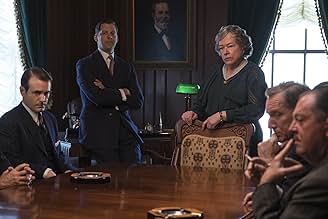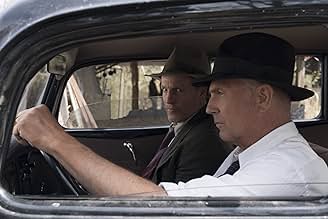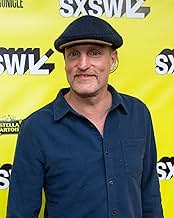Um par de Texas Rangers sai da aposentadoria para pegar os infames bandidos Bonnie e Clyde.Um par de Texas Rangers sai da aposentadoria para pegar os infames bandidos Bonnie e Clyde.Um par de Texas Rangers sai da aposentadoria para pegar os infames bandidos Bonnie e Clyde.
- Prêmios
- 3 indicações no total
Josh Caras
- Wade McNabb
- (as Joshua Caras)
Avaliações em destaque
Well, it's a hunt. And not much of it at that. The story lies within a very narrow confine of our two lead characters. There's enough background to make sense. Screenplay is mostly taut and the direction is good. But it is Harrelson and Costner that bring it all to mean much more than its mere sum. Both are excellent ... especially Costner who takes to westerns and baseball flicks like duck to water. Watch it for these two for there's not much else that you cannot gather from wikipedia.
Nevertheless one of the better addition to Netflix. Nice!
Nevertheless one of the better addition to Netflix. Nice!
It's 1934. Bonnie Parker helps Clyde Barrow escape a Texas prison work gang. Governor Miriam "Ma" Ferguson (Kathy Bates) faces public pressure. Frank Hamer (Kevin Costner) is recruited to be a highwayman with orders to take down the rampaging fugitives. He and his partner Maney Gault (Woody Harrelson) are former Texas Rangers which was disbanded in those more civilized times. The duo tracks the fugitives to their ultimate ambush deaths in Louisiana.
Netflix seems to be taking over these medium sized films. This one tackles Bonnie & Clyde but from the other side. It's fascinating that Bonnie & Clyde were and continue to be media sensations. There are countless versions of them on the small screen and the big screen. They are cultural icons. They're basically shorthand for criminal Romeo & Juliet. They are cool and hot. They are the excitement and the romantic. Almost nothing is given to those who hunted and killed them. So it's really fascinating to see these icons with the eyes of their pursuers. Whether it's Costner, the time period, or the criminal icons, this reminds me of a harsher and less glossy The Untouchables. Bonnie & Clyde are more like side characters. They are the shark in Jaws. This paints a heroic weary picture of Hamer and Gault. These are old gunslingers from the Ole West. The truth is a little muddier. The ambush is interesting which does something more than the usual. The production is pretty good although I was concerned about authenticity at the beginning. It is closer than most Hollywood production. These are great characters. Costner and Harrelson are well within their elements. This is an engaging movie as a companion piece to the countless Bonnie & Clyde movies.
Netflix seems to be taking over these medium sized films. This one tackles Bonnie & Clyde but from the other side. It's fascinating that Bonnie & Clyde were and continue to be media sensations. There are countless versions of them on the small screen and the big screen. They are cultural icons. They're basically shorthand for criminal Romeo & Juliet. They are cool and hot. They are the excitement and the romantic. Almost nothing is given to those who hunted and killed them. So it's really fascinating to see these icons with the eyes of their pursuers. Whether it's Costner, the time period, or the criminal icons, this reminds me of a harsher and less glossy The Untouchables. Bonnie & Clyde are more like side characters. They are the shark in Jaws. This paints a heroic weary picture of Hamer and Gault. These are old gunslingers from the Ole West. The truth is a little muddier. The ambush is interesting which does something more than the usual. The production is pretty good although I was concerned about authenticity at the beginning. It is closer than most Hollywood production. These are great characters. Costner and Harrelson are well within their elements. This is an engaging movie as a companion piece to the countless Bonnie & Clyde movies.
This is the True story of 2 Texas Rangers who both came out of retirement to hunt down the notorious Bonnie and Clyde. Frank Hamer (Costner) and Maney Gault (Harrelson) team up and hit the road after being hired by Texas Governor Ma Ferguson(Bates) and the Prison Warden(J K Lynch) from where Barrow escaped.
Bonnie Parker and Clyde Barrow were as famous as Movie Stars back in the 1930's and this is effectively portrayed especially at the end. Costner and Harrelson pairing works well and though maybe a bit long the Movie does its Job and so did the Bullets!
This is an extremely well put together, engaging and entertaining telling of the pursuit of Bonnie and Clyde. Woody Harrelson is at the top of his form. He's played the part of the hardbitten lawman before, but it keeps getting better. And Costner does almost as well. The interplay is absorbing and extremely well written and acted.
In western culture we love our bandit myths and legends, which for some reasons celebrate some fairly nasty characters. Knowing the real story of Bonnie and Clyde, as opposed to the myth created by the contemporary news media and J. Edgar Hoover, always made Arthur Penns near worshipful portrayal of these two blood drenched spree murderers jarring. Bonnie and Clyde were bloodthirsty sociopaths, who in fact ambushed and murdered a fair number of people, including shooting unarmed store clerks in the back. Bonnie and Clyde were not "sticking it to the man" robbing big business like banks as much as they were in fact robbing and killing owners of small stores and then committing cold blooded murder of policemen trying to stop the mass murder spree.
The ultimate "ambush" of Bonnie and Clyde was not some planned execution, it was the result of the simple fact that those two had, withing seconds of being stopped, routinely murdered police who stopped them. They also did most of their murders with simple revolvers and sawed off shotguns, and almost none of the guns used were machine guns (a documented invention of Hoover's FBI; of the twenty or so people Bonnie and Clyde shot exactly one was shot with a machine gun). Hoover was fixated on above all else a) trying to prove that his agency's high tech of the time was the best avenue, despite all evidence to the contrary, b) distracting from, even to the point of denying the existence of, organized crime that Prohibition he supported had created. Hence his spinning of "celebrity" criminals like Dillinger and Bonnie and Clyde, which also fit his narrative that we needed a national police force.
In fact FBI in fact made a mess out of their pursuit of Bonnie and Clyde, and it was old fashioned policing by two standard state lawmen that put an end to their violent spree.
So watch this film to see great buddy cop tension, and character interplay. Seriously as good as True Detective level. And a subtle subtext of well done but not over the top critique of Penn's worshipful portrayal of these two hyperviolent criminals in his 1967 film. The bumbling lawmen myth attached to to the 1967 film is also blown away. Bonnie and Clyde's murder and crime spree ranged over an area of 600,000 square miles, and it was old fashioned hard-bitten police work that got them.
Lastly the period work is another very well done element. Not just the visual elements, but the the dialogue. Instead of the fictitious Hepburn-Tracy like, now laughable, staccato dialogue of the 1967 film, we get a much more accurate laconic way of speaking at that time. More is said in fewer words between Harrelson and Costner.
Give it a watch, you will not be disappointed, although your prior positive views of the one-dimensional 67 film, may change.
In western culture we love our bandit myths and legends, which for some reasons celebrate some fairly nasty characters. Knowing the real story of Bonnie and Clyde, as opposed to the myth created by the contemporary news media and J. Edgar Hoover, always made Arthur Penns near worshipful portrayal of these two blood drenched spree murderers jarring. Bonnie and Clyde were bloodthirsty sociopaths, who in fact ambushed and murdered a fair number of people, including shooting unarmed store clerks in the back. Bonnie and Clyde were not "sticking it to the man" robbing big business like banks as much as they were in fact robbing and killing owners of small stores and then committing cold blooded murder of policemen trying to stop the mass murder spree.
The ultimate "ambush" of Bonnie and Clyde was not some planned execution, it was the result of the simple fact that those two had, withing seconds of being stopped, routinely murdered police who stopped them. They also did most of their murders with simple revolvers and sawed off shotguns, and almost none of the guns used were machine guns (a documented invention of Hoover's FBI; of the twenty or so people Bonnie and Clyde shot exactly one was shot with a machine gun). Hoover was fixated on above all else a) trying to prove that his agency's high tech of the time was the best avenue, despite all evidence to the contrary, b) distracting from, even to the point of denying the existence of, organized crime that Prohibition he supported had created. Hence his spinning of "celebrity" criminals like Dillinger and Bonnie and Clyde, which also fit his narrative that we needed a national police force.
In fact FBI in fact made a mess out of their pursuit of Bonnie and Clyde, and it was old fashioned policing by two standard state lawmen that put an end to their violent spree.
So watch this film to see great buddy cop tension, and character interplay. Seriously as good as True Detective level. And a subtle subtext of well done but not over the top critique of Penn's worshipful portrayal of these two hyperviolent criminals in his 1967 film. The bumbling lawmen myth attached to to the 1967 film is also blown away. Bonnie and Clyde's murder and crime spree ranged over an area of 600,000 square miles, and it was old fashioned hard-bitten police work that got them.
Lastly the period work is another very well done element. Not just the visual elements, but the the dialogue. Instead of the fictitious Hepburn-Tracy like, now laughable, staccato dialogue of the 1967 film, we get a much more accurate laconic way of speaking at that time. More is said in fewer words between Harrelson and Costner.
Give it a watch, you will not be disappointed, although your prior positive views of the one-dimensional 67 film, may change.
This story is told from the other perspective that we are used to see. Two aged, recommissioned(or, actually half-recommissioned) Texas Rangers take on Bonny and Clyde and hunt them in the end using same tactics that B&C used to kill lawmen. The tempo is slow at the beginning and builds up gradually until the climax. The sedate style of storytelling is intentional to give it a more realistic feel. The director Mr. Hancock achieves that masterfully! Set-design is excellent! Camerawork follows the happenings from the perspective of Pancho and Manny, and you get a clear idea of what they are facing while dealing with such criminals. There are some intense moments that will keep you on the edges of your seats!
Finally, the acting. Superb! A plus straightaway! The screen chemistry of Costner and Harrelson works like magic, and their banter wont let you feel that you are actually watching a hunting party involving some deep criminals. The last scene is simply impeccable! I'd say its a solid eight-outta-ten!
Você sabia?
- CuriosidadesWhen Texas Ranger Frank Hamer was earlier portrayed by Denver Pyle in Bonnie e Clyde: Uma Rajada de Balas (1967), he was characterized as an incompetent fool, prompting his widow Gladys to sue Warner Brothers for defamation of his character. In 1971 an out-of-court settlement was reached.
- Erros de gravaçãoDuring When Frank Hamer's talk with the gas station attendant, the attendant says that Bonnie and Clyde "only rob banks" . While it is true they did rob banks, they actually robbed more stores and gas stations by far.
The station attendant's statement-while factually incorrect-was most likely meant to reflect popular misconceptions that began while Bonnie and Clyde were alive and have persisted to the present day. Due to their less spectacular nature (and generally lower body counts), the Barrow Gang's numerous robberies of gas stations, grocery stores, and assorted small businesses were under-reported at the time, with some not being attributed to the gang until months or even years after they occurred.
- Citações
Maney Gault: Clyde might be king, but I'm a Texas Ranger, you little shit.
- Cenas durante ou pós-créditosDuring the first part of the closing credits, photos are shown of the real people and scenes portrayed.
- ConexõesEdited from The George Burns and Gracie Allen Show (1950)
- Trilhas sonorasAfraid to Dream
Written by Mack Gordon and Harry Revel
Performed by Benny Goodman and His Orchestra
Courtesy of RCA Records
By arrangement with Sony Music Entertainment
Principais escolhas
Faça login para avaliar e ver a lista de recomendações personalizadas
Detalhes
- Data de lançamento
- País de origem
- Central de atendimento oficial
- Idiomas
- Também conhecido como
- The Highwaymen
- Locações de filme
- Empresas de produção
- Consulte mais créditos da empresa na IMDbPro
Bilheteria
- Orçamento
- US$ 49.000.000 (estimativa)
- Tempo de duração2 horas 12 minutos
- Cor
- Mixagem de som
- Proporção
- 2.39 : 1
Contribua para esta página
Sugerir uma alteração ou adicionar conteúdo ausente











































